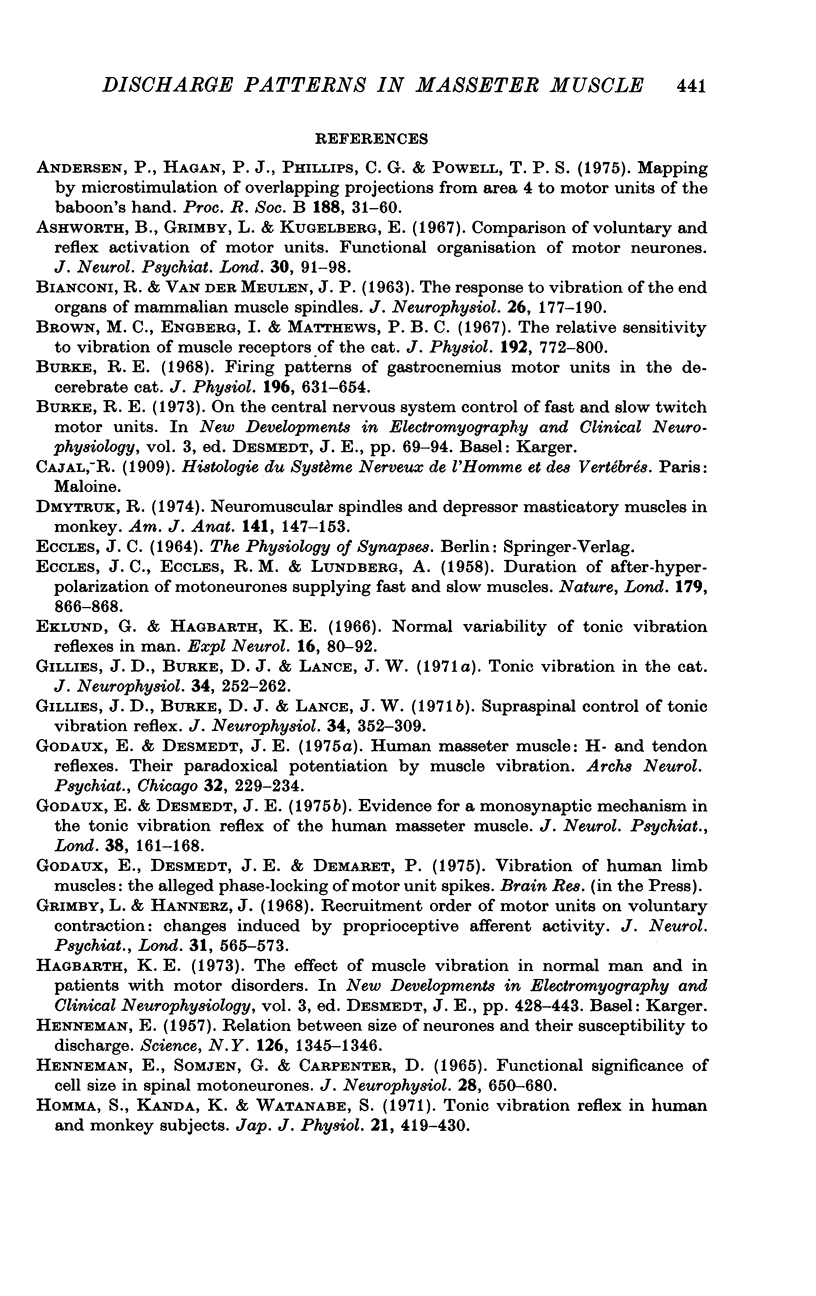Abstract
Single motor unit potentials were recorded with small bipolar wires from intact masseter muscles in the adult man and a detailed parametric analysis of the effects of muscle vibration on motor unit discharges was carried out. 2. When the vibration amplitude was kept constant, each unit started firing at a definite threshold of vibration frequency. With higher frequencies the rate of firing rapidly reached a maximum. Units recruited at higher frequencies presented a lower maximum rate of firing. 3. When the vibration frequency was kept constant, each masseter unit discharged at a definite threshold of vibration amplitude. With higher amplitudes the unit quickly reached a maximum rate of discharge. Units with a higher frequency threshold tended to also present a higher amplitude threshold. Motor unit "excitability" curves could be plotted using the combined threshold conditions for frequency and amplitude of applied vibrations. 4. With a given parametric set of vibration, the units only started firing at a given delay after the onset of vibration. The delay was quite different for different units and it increased considerably, sometimes by several seconds, when the vibration amplitude was made smaller. 5. In all the experimental conditions tested, and even when the unit discharge did not start until several seconds after vibration onset, the unit potential presented a close and highly consistent temporal relation to the vibration cycles. The slow recruitment process is thought to involve a polysynaptic excitatory mechanism which progressively depolarizes the masseter motoneurones close to their threshold, the actual firing being triggered by monosynaptic excitatory post-synaptic potentials from I(a) afferents, hence the small latency jitter recorded. This special pattern of tonic vibration reflex in jaw-closing muscles in man may result from the lack of reciprocal inhibition from the jaw-opening muscles.
Full text
PDF













Selected References
These references are in PubMed. This may not be the complete list of references from this article.
- Andersen P., Hagan P. J., Phillips C. G., Powell T. P. Mapping by microstimulation of overlapping projections from area 4 to motor units of the baboon's hand. Proc R Soc Lond B Biol Sci. 1975 Jan 21;188(1090):31–36. doi: 10.1098/rspb.1975.0002. [DOI] [PubMed] [Google Scholar]
- Ashworth B., Grimby L., Kugelberg E. Comparison of voluntary and reflex activation of motor units. Functional organization of motor neurones. J Neurol Neurosurg Psychiatry. 1967 Apr;30(2):91–98. doi: 10.1136/jnnp.30.2.91. [DOI] [PMC free article] [PubMed] [Google Scholar]
- BIANCONI R., van der MEULEN J. The response to vibration of the end organs of mammalian muscle spindles. J Neurophysiol. 1963 Jan;26:177–190. doi: 10.1152/jn.1963.26.1.177. [DOI] [PubMed] [Google Scholar]
- Brown M. C., Engberg I., Matthews P. B. The relative sensitivity to vibration of muscle receptors of the cat. J Physiol. 1967 Oct;192(3):773–800. doi: 10.1113/jphysiol.1967.sp008330. [DOI] [PMC free article] [PubMed] [Google Scholar]
- Burke R. E. Firing patterns of gastrocnemius motor units in the decerebrate cat. J Physiol. 1968 Jun;196(3):631–654. doi: 10.1113/jphysiol.1968.sp008527. [DOI] [PMC free article] [PubMed] [Google Scholar]
- Dmytruk R. J. Neuromuscular spindles and depressor masticatory muscles of monkey. Am J Anat. 1974 Sep;141(1):147–153. doi: 10.1002/aja.1001410111. [DOI] [PubMed] [Google Scholar]
- ECCLES J. C., ECCLES R. M., LUNDBERG A. Durations of after-hyperpolarization of motoneurones supplying fast and slow muscles. Nature. 1957 Apr 27;179(4565):866–868. doi: 10.1038/179866b0. [DOI] [PubMed] [Google Scholar]
- Eklund G., Hagbarth K. E. Normal variability of tonic vibration reflexes in man. Exp Neurol. 1966 Sep;16(1):80–92. doi: 10.1016/0014-4886(66)90088-4. [DOI] [PubMed] [Google Scholar]
- Gillies J. D., Burke D. J., Lance J. W. Supraspinal control of tonic vibration reflex. J Neurophysiol. 1971 Mar;34(2):302–309. doi: 10.1152/jn.1971.34.2.302. [DOI] [PubMed] [Google Scholar]
- Gillies J. D., Burke D. J., Lance J. W. Tonic vibration reflex in the cat. J Neurophysiol. 1971 Mar;34(2):252–262. doi: 10.1152/jn.1971.34.2.252. [DOI] [PubMed] [Google Scholar]
- Godaux E., Desmedt J. E. Evidence for a monosynaptic mechanism in the tonic vibration reflex of the human masseter muscle. J Neurol Neurosurg Psychiatry. 1975 Feb;38(2):161–168. doi: 10.1136/jnnp.38.2.161. [DOI] [PMC free article] [PubMed] [Google Scholar]
- Godaux E., Desmedt J. E. Human masseter muscle: H- and tendon reflexes. Their paradoxical potentiation by muscle vibration. Arch Neurol. 1975 Apr;32(4):229–234. doi: 10.1001/archneur.1975.00490460045005. [DOI] [PubMed] [Google Scholar]
- Grimby L., Hannerz J. Recruitment order of motor units on voluntary contraction: changes induced by proprioceptive afferent activity. J Neurol Neurosurg Psychiatry. 1968 Dec;31(6):565–573. doi: 10.1136/jnnp.31.6.565. [DOI] [PMC free article] [PubMed] [Google Scholar]
- HENNEMAN E. Relation between size of neurons and their susceptibility to discharge. Science. 1957 Dec 27;126(3287):1345–1347. doi: 10.1126/science.126.3287.1345. [DOI] [PubMed] [Google Scholar]
- Homma S., Kanda K., Watanabe S. Tonic vibration reflex in human and monkey subjects. Jpn J Physiol. 1971 Aug;21(4):419–430. doi: 10.2170/jjphysiol.21.419. [DOI] [PubMed] [Google Scholar]
- Kernell D. Input resistance, electrical excitability, and size of ventral horn cells in cat spinal cord. Science. 1966 Jun 17;152(3729):1637–1640. doi: 10.1126/science.152.3729.1637. [DOI] [PubMed] [Google Scholar]
- Kubota K., Masegi T., Osanai K. Proprioceptive innervation in the masticatory muscle of Temminck's mole, Mogera wogura (Temminck, 1842). Anat Rec. 1974 Jul;179(3):375–383. doi: 10.1002/ar.1091790308. [DOI] [PubMed] [Google Scholar]
- Marsden C. D., Meadows J. C., Hodgson H. J. Observations on the reflex response to muscle vibration in man and its voluntary control. Brain. 1969;92(4):829–846. doi: 10.1093/brain/92.4.829. [DOI] [PubMed] [Google Scholar]
- Matthews P. B. The reflex excitation of the soleus muscle of the decerebrate cat caused by vibbration applied to its tendon. J Physiol. 1966 May;184(2):450–472. doi: 10.1113/jphysiol.1966.sp007926. [DOI] [PMC free article] [PubMed] [Google Scholar]
- Tanji J., Kato M. Firing rate of individual motor units in voluntary contraction of abductor digiti minimi muscle in man. Exp Neurol. 1973 Sep;40(3):771–783. doi: 10.1016/0014-4886(73)90111-8. [DOI] [PubMed] [Google Scholar]
- Tanji J., Kato M. Recruitment of motor units in voluntary contraction of a finger muscle in man. Exp Neurol. 1973 Sep;40(3):759–770. doi: 10.1016/0014-4886(73)90110-6. [DOI] [PubMed] [Google Scholar]
- VOSS H. Zahl und Anordnung der Muskelspindeln in den oberen Zungenbeinmuskeln, im M. trapezius und M. latissimus dorsi. Anat Anz. 1956 Dec 28;103(21-24):443–446. [PubMed] [Google Scholar]
- Westbury D. R. A study of stretch and vibration reflexes of the cat by intracellular recording from motoneurones. J Physiol. 1972 Oct;226(1):37–56. doi: 10.1113/jphysiol.1972.sp009972. [DOI] [PMC free article] [PubMed] [Google Scholar]


